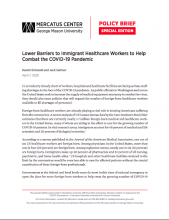Lower Barriers to Immigrant Healthcare Workers to Help Combat the COVID-19 Pandemic
In an industry already short of workers, hospitals and healthcare facilities are facing serious staffing shortages in the face of the COVID-19 pandemic. As public officials in Washington and across the United States seek to increase the supply of medical equipment necessary to combat the virus, they should also enact policies that will expand the number of foreign-born healthcare workers available to fill shortages of personnel.
Foreign-born healthcare workers are already playing a vital role in treating Americans suffering from the coronavirus. A recent analysis of US Census Bureau data by the Cato Institute’s David Bier estimates that there are currently nearly 1.7 million foreign-born medical and healthcare workers in the United States, many of whom are aiding in the effort to care for the growing number of COVID-19 patients. In vital research areas, immigrants account for 40 percent of medical and life scientists and 20 percent of biological scientists.
According to a survey published in the Journal of the American Medical Association, one out of six US healthcare workers are foreign born. Among physicians in the United States, more than one in four (29 percent) are foreign born. Among registered nurses, nearly one in six (16 percent) are foreign born. Immigrants make up 20 percent of pharmacists and 23 percent of all nursing, psychiatric, and home health aides.2 US hospitals and other healthcare facilities strained to the limit by the coronavirus would be even less able to care for affected patients without the crucial contribution of these foreign-born professionals.
Griswold, D., & Salmon, J. (2020, April 7). Lower Barriers to Immigrant Healthcare Workers to Help Combat the COVID-19 Pandemic. George Mason University Mercatus Center.

